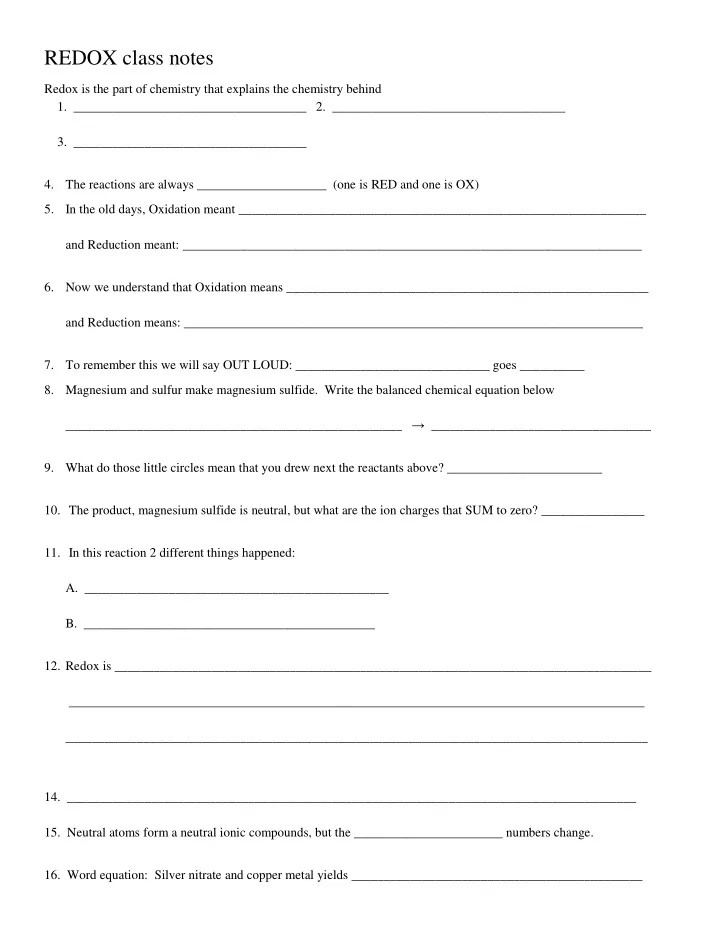

REDOX class notes Redox is the part of chemistry that explains the chemistry behind 1. ____________________________________ 2. ____________________________________ 3. ____________________________________ 4. The reactions are always ____________________ (one is RED and one is OX) 5. In the old days, Oxidation meant _______________________________________________________________ and Reduction meant: _______________________________________________________________________ 6. Now we understand that Oxidation means ________________________________________________________ and Reduction means: _______________________________________________________________________ 7. To remember this we will say OUT LOUD: ______________________________ goes __________ 8. Magnesium and sulfur make magnesium sulfide. Write the balanced chemical equation below ____________________________________________________ → __________________________________ 9. What do those little circles mean that you drew next the reactants above? ________________________ 10. The product, magnesium sulfide is neutral, but what are the ion charges that SUM to zero? ________________ 11. In this reaction 2 different things happened: A. _______________________________________________ B. _____________________________________________ 12. Redox is ___________________________________________________________________________________ _________________________________________________________________________________________ __________________________________________________________________________________________ 14. ________________________________________________________________________________________ 15. Neutral atoms form a neutral ionic compounds, but the _______________________ numbers change. 16. Word equation: Silver nitrate and copper metal yields _____________________________________________
17. Balanced chemical equation silver nitrate solution and copper yields copper (I) nitrate and silver metal. ______________________________________________________________________________________ 18. Add in the oxidation numbers (ionic charges) for the reaction above. 19. The Silver Ions ___________ electrons, the Ag +1 are ________________ 20. The Copper atoms ___________ electrons, the Cu° are _______________ 21. The nitrate ions are still swimming around in the beaker. They are the ______________________ ions. 22. Li (S) + NaCl (AQ) → LiCl (AQ) + Na (S) is a single replacement/redox reaction. Write the 2 half reactions ½OX: ______________________________________________________________________ ½OX: ______________________________________________________________________ NET: ______________________________________________________________________ 23. _____________________________________________________________________________________ ____________________________________________________________. The spectator ion is _______ 24. Mg (S) + 2HCl (AQ) → MgCl 2(AQ) + H 2(G) is a SR/ redox reaction. Write it below as 2 half reactions ½OX: ______________________________________________________________________ ½OX: ______________________________________________________________________ NET: ______________________________________________________________________ 25. Here, the Mg atoms are oxidized into ____________. The H +1 cations are reduced to ________________ 26. In this case, ____ electrons are oxidized, so ____ electrons must be reduced. The electron transfer MUST be in balance!
27. Write the balanced chemical reaction for this word equation: Sodium atoms + chlorine molecules synthesize into table salt ___________________________________________________________________________________ is a synthesis/redox reaction. Write it below as 2 half reactions ½OX: ______________________________________________________________________ ½OX: ______________________________________________________________________ NET: __________________________________________________________________ _______________________________________________________________________________________ 28. Oxidation numbers for ions are easy; they are just the __________________________________ 29. The oxidation number for the sodium cation is _____, For the chloride anion it is ______, for the sulfate anion (table E), it’s _____, for magnesium cation it is ______. 30. For all atoms (+ the HONClBrIF twins) the oxidation number is _______, because they have no charge. 31. Inside molecules, like carbon dioxide (no ions) there are still oxidation numbers. What are the individual oxidation numbers for all of these species? (they better sum to zero!) CO 2 __________________________ CO _________________________________ CaCl 2 ________________________ NO 2 ________________________________ PCl 3 _________________________ PCl 5 ______________________________ -2 ___________________________ (special) H 2 SO 4 ________________________ Cr 2 O 7 NbBr 5 _______________________________________________
32. Write a balanced chemical equation for: Silver nitrate solution + copper forms copper (II) nitrate solution and silver _______________________________________________________________________________________ 33. What species is oxidized? __________________ 34. What species is reduced? _________________ 35. Name the spectator ion_______________ 36. Write it below as 2 half reactions, plus the NET IONIC EQUATION ½OX: ______________________________________________________________________ ½OX: ______________________________________________________________________ NET: ______________________________________________________________________ 37. _________________________________________________________________________________ 38. _____________________________________________________________________________________ _____________________________________________________________________________________ On the next page we will “take a battery apart, and slowly show you what is going on, how it works, etc. It’s going to be complicated at first, really complicated. Pay attention now. Do things in order, don’t doze off. We’re going to label this now. It shows two beakers of solution, with a piece of metal in each one, connected by a wire. There’s also a glass tube with a solution in it, and cotton balls (not drawn) connecting the two solutions. At top is a bulb, which would light up if electricity goes through the wire. TAKE OUT TABLE J, for Janet, please.
½OX: ______________________________________________________________________ ½RED: ______________________________________________________________________ NET: ______________________________________________________________________ 40. How do we decide which of the metals here will oxidize using table J? 41. Oxidation releases electrons, creating cations that jump into solution. Cations are positively charged. These cations jump into a neutral solution, making the solution become ________ charged. 42. This solution, now positively charged, will attract ions from the salt bridge, which will neutralize the so- lution. A positive solution attracts __________ ions. 43. In the opposite beaker, where cations are forming into atoms on the cathode, the neutral solution is losing the positive cations, making that solution become negatively charged. This negative solution will attract the __________ salt ions to neutralize the solution.
46 ½OX: ½RED: NET: 47. What are the 3 reasons that EVERY SINGLE battery dies, including this one? A. B. C.
48. Completely Label this voltaic cell ½ Oxidation: _____________________________________________________ ½ Reduction: _____________________________________________________ Net Ionic Equation: ___________________________________________________ 50. State the 3 specific reasons that THIS voltaic cell will die.
½ Oxidation: _____________________________________________________ ½ Reduction: _____________________________________________________ Net Ionic Equation: ___________________________________________________ 53. State the 3 specific reasons that THIS voltaic cell will die.
54. Write both half reactions, then the net ionic equation. ½ Oxidation: _____________________________________________________ ½ Reduction: _____________________________________________________ Net Ionic Equation: ___________________________________________________ 55. State the 3 specific reasons that THIS voltaic cell will die. Run out of 56. There are two kinds of ELECTROCHEMICAL CELLS, the one we know, Voltaic cells, and a new one called the __________________________________________ Cell. 57. Voltaic cells have chemistry spontaneously creating electricity. An electrolytic cell REQUIRES ____________________ to force a chemical reaction. 58. There are 2 kinds of electrochemical cells, the _____________________ + the __________________________________ cell.
Recommend
More recommend